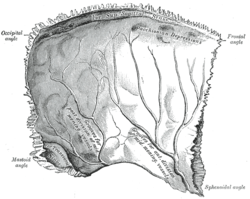Introduction and Anatomy of the Middle Meningeal Nerve
- The Middle Meningeal Nerve is a branch of the maxillary nerve.
- It is responsible for providing sensory innervation to the meninges, the covering of the brain.
- The nerve is derived from the embryonic trigeminal ganglion.
- The middle meningeal nerve is located within the skull, specifically in the middle cranial fossa.
- It exits the skull through the foramen spinosum.
- It runs between the dura mater and the calvaria, the outer layer of the skull.
- The nerve branches out into smaller nerves that innervate different regions of the meninges.
- The middle meningeal nerve communicates with other nerves, such as the ophthalmic nerve and the otic ganglion.
- It has a close relationship with the middle meningeal artery, with which it forms the middle meningeal artery-nervous ring.
Function of the Middle Meningeal Nerve
- The primary function of the middle meningeal nerve is to provide sensory innervation to the meninges.
- It carries pain and temperature sensations from the meninges to the brain.
- The middle meningeal nerve also plays a role in regulating blood flow to the meninges.
- Damage to the nerve can result in sensory deficits and pain disorders in the head and face.
- Dysfunction of the middle meningeal nerve can contribute to conditions like migraines and cluster headaches.
Clinical Significance of the Middle Meningeal Nerve
- The middle meningeal nerve is susceptible to injury, particularly during skull fractures.
- Trauma to the nerve can lead to complications such as epidural hematomas.
- Surgical procedures involving the middle meningeal nerve may be necessary for certain medical conditions.
- Diagnostic techniques, such as nerve blocks, can be used to identify issues with the middle meningeal nerve.
- Understanding the anatomy and function of the middle meningeal nerve is crucial for neurosurgeons and other healthcare professionals.
Research and Future Perspectives
- Ongoing research aims to further understand the role of the middle meningeal nerve in pain disorders.
- Advanced imaging techniques, such as magnetic resonance imaging (MRI), allow for better visualization of the nerve.
- New treatment options, such as nerve stimulation and targeted drug delivery, are being explored for middle meningeal nerve-related conditions.
- Collaborative efforts between neurologists, neurosurgeons, and researchers are essential for advancing knowledge in this field.
- Further investigation into the embryological development and anatomical variations of the middle meningeal nerve may lead to improved surgical techniques and patient outcomes.
Statistics and Detailed Points
- The middle meningeal nerve is closely associated with the middle meningeal artery, which supplies blood to the meninges.
- Damage to the middle meningeal nerve can result in sensory deficits and pain disorders in the head and face.
- Dysfunction of the middle meningeal nerve can contribute to conditions like migraines and cluster headaches.
- The middle meningeal nerve is susceptible to injury, particularly during skull fractures.
- Trauma to the nerve can lead to complications such as epidural hematomas.
- Diagnostic techniques, such as nerve blocks, can be used to identify issues with the middle meningeal nerve.
- Advanced imaging techniques, such as magnetic resonance imaging (MRI), allow for better visualization of the nerve.
- New treatment options, such as nerve stimulation and targeted drug delivery, are being explored for middle meningeal nerve-related conditions.
The middle meningeal nerve (meningeal or dural branch) is given off from the maxillary nerve (CN V2) directly after its origin from the trigeminal ganglion, before CN V2 enters the foramen rotundum.
| Middle meningeal nerve | |
|---|---|
 Left parietal bone. Inner surface. (Nerve not labeled, but grooves visible at bottom.) | |
| Details | |
| Innervates | meninges |
| Identifiers | |
| Latin | nervus meningeus medius |
| TA98 | A14.2.01.038 |
| TA2 | 6217 |
| FMA | 52728 |
| Anatomical terms of neuroanatomy | |
It accompanies the middle meningeal artery and vein as the artery and vein enter the cranium through the foramen spinosum and supplies the dura mater.